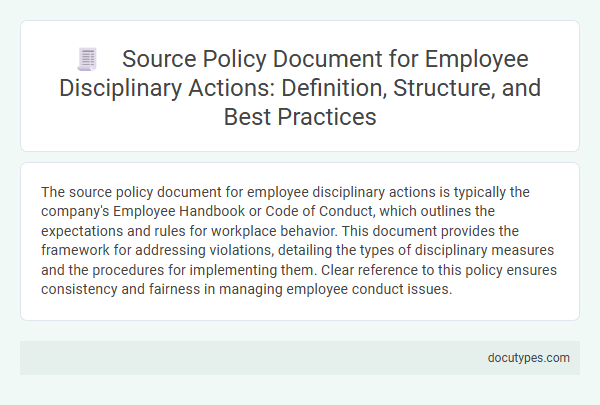The source policy document for employee disciplinary actions is typically the company's Employee Handbook or Code of Conduct, which outlines the expectations and rules for workplace behavior. This document provides the framework for addressing violations, detailing the types of disciplinary measures and the procedures for implementing them. Clear reference to this policy ensures consistency and fairness in managing employee conduct issues.
Introduction to Source Policy Documents for Employee Discipline
Source policy documents for employee disciplinary actions establish the framework for maintaining workplace standards and addressing misconduct. These documents provide clear guidelines and procedures for managing disciplinary issues effectively.
They serve as the authoritative reference to ensure consistency and fairness in handling employee behavior and performance concerns. Understanding these source policies is essential for both employers and employees to uphold organizational integrity and compliance.
Definition of Employee Disciplinary Policy Documents
Employee disciplinary policy documents outline the rules and procedures governing employee conduct and the consequences of violations. These documents serve as the official source for enforcing workplace discipline and ensuring fair treatment.
- Definition - Employee disciplinary policy documents are formal records that detail acceptable behaviors, disciplinary steps, and penalties within an organization.
- Purpose - These documents provide clarity and consistency in handling employee misconduct to maintain workplace order.
- Your Role - You must refer to the policy document as the authoritative guide when addressing any disciplinary actions to ensure compliance and fairness.
Purpose and Importance of Disciplinary Policies
| Aspect | Details |
|---|---|
| Source Policy Document | Employee Disciplinary Action Policy or Employee Conduct Policy |
| Purpose | Defines acceptable workplace behavior and outlines consequences for violations. Establishes a clear framework to address employee misconduct consistently. Protects organizational integrity by ensuring accountability. Supports legal compliance and reduces risk of wrongful termination claims. Enhances communication between management and employees regarding performance standards. |
| Importance | Promotes a fair and transparent disciplinary process. Reinforces workplace standards and company values. Helps maintain a productive and respectful work environment. Facilitates early intervention to correct employee behavior. Serves as a reference for supervisors and HR during disciplinary investigations and actions. |
Key Components of a Disciplinary Policy Document
The source policy document for employee disciplinary actions serves as the official guideline outlining acceptable behavior and the consequences of violations. It establishes a clear framework to ensure consistent and fair treatment of all employees within an organization.
Key components of a disciplinary policy document include a detailed description of prohibited conduct, a step-by-step outline of the disciplinary process, and the roles and responsibilities of supervisors and employees. The document typically defines varying levels of infractions and corresponding penalties to ensure proportional responses. Furthermore, it highlights employee rights, appeal procedures, and ensures compliance with labor laws and regulations.
Structure and Format of Disciplinary Policy Documents
Employee disciplinary actions are guided by a source policy document that clearly outlines the rules and procedures. The structure typically includes sections such as purpose, scope, definitions, types of violations, disciplinary measures, and the appeals process. Your understanding of the format ensures consistency, transparency, and fairness in handling disciplinary matters within the organization.
Legal and Regulatory Considerations
The source policy document for employee disciplinary actions is typically the company's Employee Handbook or Code of Conduct, which outlines acceptable behavior and consequences for violations. Legal and regulatory considerations demand that these policies comply with labor laws, anti-discrimination statutes, and workplace safety regulations to ensure fairness and avoid litigation. Your organization must regularly review and update the policy to align with changes in employment law and regulatory standards.
Steps in Developing a Source Disciplinary Policy Document
What Is the Source Policy Document for Employee Disciplinary Actions? The source policy document provides a clear framework outlining acceptable behavior and consequences for violations. It serves as the foundation for consistent and fair disciplinary measures within an organization.
What Are the Steps in Developing a Source Disciplinary Policy Document? Begin by researching relevant labor laws and company regulations to ensure compliance and relevance. You must engage stakeholders to gather input, draft clear guidelines, and establish procedures for handling disciplinary cases effectively.
How Do You Ensure the Policy Document Is Clear and Enforceable? Use precise language and define key terms to eliminate ambiguity. Include a step-by-step process for reporting, investigating, and resolving disciplinary issues to promote transparency.
Why Is Reviewing and Updating the Policy Document Important? Regular reviews allow the policy to stay current with legal changes and organizational needs. This helps maintain fair treatment and reduces the risk of disputes or legal challenges.
Best Practices for Implementing Disciplinary Policies
The source policy document for employee disciplinary actions establishes the framework for maintaining workplace standards and addressing violations. Best practices for implementing disciplinary policies ensure fairness, consistency, and legal compliance in handling employee behavior.
- Clear Documentation - Ensure your disciplinary policy is detailed and accessible to all employees to promote understanding and transparency.
- Consistent Enforcement - Apply disciplinary measures uniformly across all staff to avoid bias and maintain trust within the organization.
- Regular Training - Provide ongoing education for managers and HR personnel on policy updates and fair disciplinary procedures to enhance effective implementation.
Common Challenges and Solutions in Policy Enforcement
The source policy document for employee disciplinary actions is typically the organization's Employee Handbook or Code of Conduct. This document outlines the procedures, expectations, and consequences related to disciplinary measures.
- Ambiguity in Policy Language - Vague terms in policies can lead to inconsistent enforcement and misunderstandings among employees.
- Lack of Management Training - Insufficient training for supervisors often results in improper application of disciplinary actions.
- Inconsistent Enforcement - Unequal treatment of employees can cause morale issues and increase legal risks.
Clear, well-communicated policies combined with thorough manager training improve fair and consistent enforcement of disciplinary actions.
What Is the Source Policy Document for Employee Disciplinary Actions? Infographic

